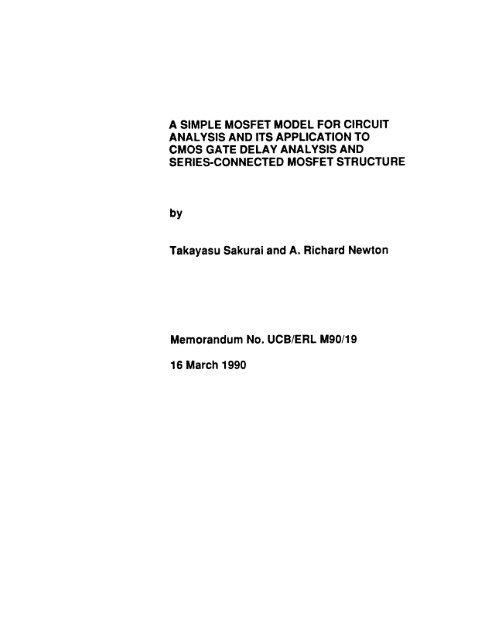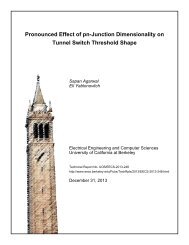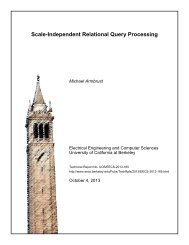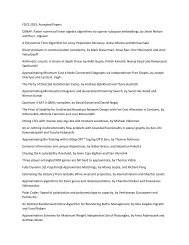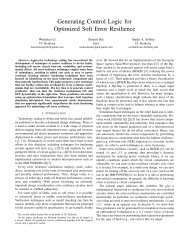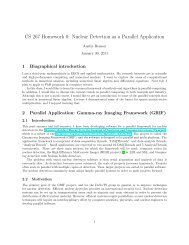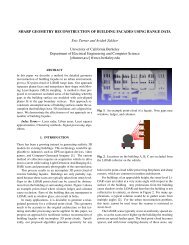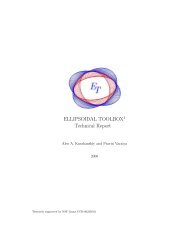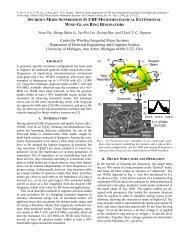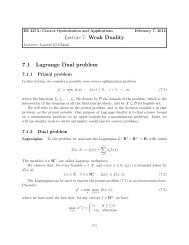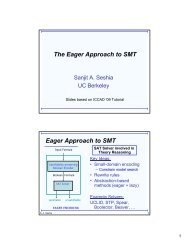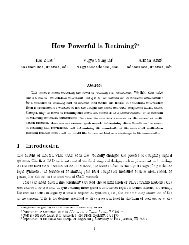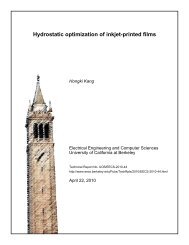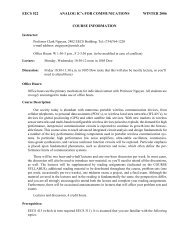simple mosfet model for circuit - Electrical Engineering & Computer ...
simple mosfet model for circuit - Electrical Engineering & Computer ...
simple mosfet model for circuit - Electrical Engineering & Computer ...
You also want an ePaper? Increase the reach of your titles
YUMPU automatically turns print PDFs into web optimized ePapers that Google loves.
A SIMPLE MOSFET MODEL FOR CIRCUIT<br />
ANALYSIS AND ITS APPLICATION TO<br />
CMOS GATE DELAY ANALYSIS AND<br />
SERIES-CONNECTED MOSFET STRUCTURE<br />
Takayasu Sakurai and A. Richard Newton<br />
Memorandum No. UCB/ERL M90/19<br />
16 March 1990
A SIMPLE MOSFET MODEL FOR CIRCUIT<br />
ANALYSIS AND ITS APPLICATION TO<br />
CMOS GATE DELAY ANALYSIS AND<br />
SERIES-CONNECTED MOSFET STRUCTURE<br />
by<br />
Takayasu Sakurai and A. Richard Newton<br />
Memorandum No. UCB/ERL M90/19<br />
16 March 1990<br />
ELECTRONICS RESEARCH LABORATORY<br />
College of <strong>Engineering</strong><br />
University of Cali<strong>for</strong>nia, Berkeley<br />
94720
A Simple MOSFET Model <strong>for</strong> Circuit Analysis and its<br />
Application to CMOS Gate Delay Analysis and Series-<br />
Connected MOSFET Structure<br />
Takayasu Sakurai' and A. Richard Newton<br />
Department of <strong>Electrical</strong> <strong>Engineering</strong> and <strong>Computer</strong> Sciences<br />
University of Califi<strong>for</strong>nia, Berkeley, CA94720, U.S.A.<br />
*) On leave from Semiconductor Device <strong>Engineering</strong> Lab.,<br />
Toshiba Corporation, Kawasaki, 210, Japan<br />
Contents<br />
This report consists of two parts. The fvst half titled "A Simple MOSFET Model <strong>for</strong><br />
Simulators and Circuit Analysis" describes a new <strong>simple</strong> yet realistic MOSFET <strong>model</strong> which is<br />
suitable <strong>for</strong> analytical treatment of MOSFm <strong>circuit</strong>s. The second part is dedicated to a application of<br />
the MOS <strong>model</strong> to series-connected MOSFET structures. The title of the second half is "CMOS Gate<br />
Delay Analysis in the Submicron Region and its Application to Series-Connected MOSFETs".<br />
The first half<br />
"A Simple MOSFET Model <strong>for</strong> Simultors and Circuit Analysis"<br />
The second half<br />
PP.2 - 18<br />
"CMOS Gate Delay Analysis in the Submicron Region and its Application to Series-Connected<br />
MOSFETs" pp. 19-+7
A Simple MOSFET Model <strong>for</strong> Simulators and<br />
Circuit Analysis<br />
Takayasu Sakurai* and A. Richard Newton<br />
Department of <strong>Electrical</strong> <strong>Engineering</strong> and <strong>Computer</strong> Sciences<br />
University of Cali<strong>for</strong>nia, Berkeley, CA94720, U.S.A.<br />
* On leave from Semiconductor Device <strong>Engineering</strong> Lab.,<br />
Toshiba Corporation, Kawasaki, 210 Japan.<br />
Abstract<br />
A <strong>simple</strong>, general and realistic MOSFET <strong>model</strong> is introduced. The <strong>model</strong> can<br />
express the current characteristics of short-channel MOSFETs at least down to 0 . 2 5 ~<br />
channel-length, GaAs FET, and resistance inserted MOSFETs. The <strong>model</strong> evaluation<br />
time is about 1/3 of the evaluation time of the SPICE3 MOS LEVEL3 <strong>model</strong>. The<br />
<strong>model</strong> parameter extraction is done by solving single variable equations and thus can<br />
be done within a second, being different from the fining procedure with expensive<br />
numerical iterations employed <strong>for</strong> the conventional <strong>model</strong>s. The <strong>model</strong> also enables<br />
analytical treatments of <strong>circuit</strong>s in shon-channel region and makes up <strong>for</strong> a missing<br />
link between a complicated MOSFET current characteristics and <strong>circuit</strong> behaviors in<br />
the deep submicron region.<br />
2
TJakurai & ARArwwn A Simple MOSFET Model <strong>for</strong> Simulators ...<br />
1. Introduction<br />
The SPICE LEVELl <strong>model</strong>[l], which is based on the Shockley <strong>model</strong>, is widely<br />
used in <strong>circuit</strong> analysis However, the I-V characteristics reproduced by the <strong>model</strong> is far<br />
from accurate in the shon-channel region as shown in Fig. 1. There is a discussion<br />
that even if it does not <strong>model</strong> the individual MOSFET characteristics accurately, it<br />
might predict the relative gate delay conectly. However, it has been shown that this is<br />
not true in the submicron region[2]. For example, in the submicron region, an 8-input<br />
KA.?? shows only 4’5 times longer delay compared with an invener when the input<br />
is fast and an output capacitance is very large. This is because the series-connected<br />
MOSFETs structure used in the NAND structure mitigates the VDS and VGS of each<br />
MOSFET and this in turn reduces the severe velocity saturation effect observed in the<br />
submicron region. The simulation with the Shockley <strong>model</strong> always shows mort than 8<br />
times longer delay <strong>for</strong> the &input NAND gate compared with an invener, because it<br />
does not include the velocity-saturation effects at all. So even <strong>for</strong> first-order approxi-<br />
mation, SPICE LEVELl <strong>model</strong> is not sufficient.<br />
On the other hand, there are more precise MOS <strong>model</strong>s like SPICE LEVEL3<br />
<strong>model</strong>[3], BSIh4[4], table look-up <strong>model</strong>s[5], and so on[6,7]. However, some of them<br />
are time-consuming in evaluating <strong>model</strong>s[3] and some of them needs special system<br />
with hardware/software combination <strong>for</strong> extracting <strong>model</strong> parameters[4,5,6] and the<br />
number of parameters is huge. Moreover, most of the precise <strong>model</strong>s[3,4,6,7] need a<br />
<strong>model</strong> parameter extraction procedure with expensive numerical iterations[8,9] and<br />
once the extracted <strong>model</strong> parameters happen not to give a satisfactory results, there is<br />
no way to know whether the problem lies in the <strong>model</strong> itself or in the extracting pro-<br />
cedure. Sometimes it takes hours to struggle with the parameter set. In a word, they<br />
3
TSakurai & ARfiewton A Simple MOSFET Model <strong>for</strong> Simulators ...<br />
lack of the easy-to-use feature.<br />
In order to fill the gap between the too <strong>simple</strong> LEVEL1 <strong>model</strong> and the more pn-<br />
cise <strong>model</strong>s, a new <strong>model</strong> is proposed in this paper. The new <strong>model</strong> offers a fast,<br />
easy-to-use, general and realistic feature at a cost of rough approximation near and<br />
below the threshold voltage. The near- and sub- threshold region <strong>model</strong>ing is not<br />
important in calculating delay of most VLSIs. The <strong>model</strong>ing of the region is impor-<br />
tant in estimating the charge decay characteristic of charge storage nodes but in this<br />
case a statistical <strong>model</strong> should be used since it is very sensitive to process variation.<br />
The fast <strong>model</strong> is suitable especially <strong>for</strong> timing simulators and electrical-logic<br />
simulators[17,18], where the <strong>model</strong> evaluation is the most time-consuming pan of the<br />
progam and the use of the complicated <strong>model</strong> greatly reduce their attractiveness.<br />
The <strong>model</strong> is presented in Section 2. The <strong>model</strong> parameter set is compact and<br />
can be used <strong>for</strong> exchanging MOSFET infomation among institutions instead of<br />
LEVEL3 <strong>model</strong> parameter set. The <strong>model</strong> parameter extraction is done easily as is<br />
explained in Section 3. Section 4 is dedicated <strong>for</strong> the property of the proposed <strong>model</strong><br />
implemented in SPICE3.<br />
The proposed <strong>model</strong> also enables an analytical treaunent of <strong>circuit</strong> operation,<br />
which helps the general understanding of <strong>circuit</strong> behavior in the submicron region.<br />
The analysis is described in Section 5 followed by the conclusion in Section 6.
TSahrar & ARNewwn A Simple MOSFET Model <strong>for</strong> Simulators ...<br />
2. Model Description<br />
The proposed <strong>model</strong> equations are as follows. ID is the drain currcnt.<br />
where VOS, VDS and VBS are gate-source, drain-source, bulk-source voltages, respec-<br />
tively. W is a channel width and Le* is an effective channel length. Vm denotes a<br />
threshold voltage, VDsAT a drain saturation voltage, and IDSAT a drain saturation<br />
current. Vm, y and 2+~ arc parameters whch describe the threshold voltage. Parame-<br />
ters K and m control the linear region characteristics while B and n determine the<br />
saturated region characteristics. & and AI are related to the finite drain conductance in<br />
the saturated region.<br />
The <strong>model</strong> is reduced to the Shockley <strong>model</strong> if K=l, m=l, B=O.SKp, and n=2.<br />
The <strong>model</strong> can also express an I-V characteristics where VDSAT is proportional to<br />
(VGS-V~)~.' and IDSAT is proportional to (VGS-V~), which is predicted by a short-<br />
channel MOSFET theory[lO]. An application of the <strong>model</strong> to 0 . 2 5 MOSF=s[6] ~ is<br />
shown in Figs. 2-7. The results are satisfactory. The <strong>model</strong> parameters are listed in<br />
TABLE 1. The primitive version of this <strong>model</strong> is seen in Ref.[11] but the linear<br />
5
TSakwai & ARhrnvton A Sunple MOSFET M e 1 <strong>for</strong> Simlotors ...<br />
region <strong>model</strong>ing was very coarse.<br />
In the submicron devices, the contact resistance dram/source diffusion resistance<br />
and hot-carrier induced drain resistance[l2] are indispensable. So it is better <strong>for</strong> the<br />
contemporary MOS <strong>model</strong> to incorporate these resistance effects in current parameters.<br />
If the series resistance is <strong>model</strong>ed by resistors, it is practically difficult to separate<br />
these resistance component and the resistors increase number of nodes and hence cal-<br />
culation time. Since the present <strong>model</strong> is quite general, it can reproduce the I-V<br />
curves of resistor-inserted MOSFET only by changing parameters. An example is<br />
shown in Fig. 8, when resistors whose value is 10% of the effective MOSFET resis-<br />
tance are inserted in the drain and the source.<br />
To demonstrate that the <strong>model</strong> is quite general, the <strong>model</strong> is applied to GaAs<br />
FET[13] in Fig. 9. The salient feature of the GaAs FET is that VDsAr is constant and<br />
not a function of VGS.<br />
3. Parameter Extraction<br />
The <strong>model</strong> parameter extract1,- starts by selecting fitting points on the I-V<br />
curves like in Fig. 10. Then the foilowing <strong>for</strong>mulas give all the parameters. The<br />
subindex ",i" (i = 1-11) corresponds to the fitting point number in the figure.<br />
(3.1)<br />
123=1D3/(1 +hvDS.3) v IZo=ID.4/(1 +&vDS.4) 9 Iz~=ID,~/(~ +&vDS,5) (3.2)<br />
Then, Vm can be obtained by solving the following equation. The bisection<br />
method[l4] is the best choice <strong>for</strong> the solution since it finds out the root without fail<br />
6
TSaAurai & ARfiewton A Simple MOSFET Model <strong>for</strong> Simulators ...<br />
within 10 iterations.<br />
fvWTO)=l0g [e]<br />
[ log VGS.4'VTU ] [5] [ - log log vGS.<br />
VGS.TVTO vGS,4-vT0<br />
is obtained from the following equation.<br />
Tv7U ]=o (3.3)<br />
(3.4)<br />
(3.5)<br />
(3.6)<br />
(3.7)<br />
(3.8)<br />
(3.9)<br />
(3.10)<br />
(2.1 1)<br />
After obtaining Vms and V ~ using Q the above equations, 2$~ is obtained by solving<br />
the following equation with the bisection method.<br />
(3.12)<br />
Even if the fining results are not satisfying at the first trial it is easy and fast to<br />
7
T.Sahuai & ARNmton A Sunpb MOSFET Model <strong>for</strong> Simularors ...<br />
ny again with slightly different fitting points, since the <strong>model</strong> parameters are<br />
appearance-oriented, that is, they have a direct meaning in controlling I-V curve shapes<br />
and they are nondegenerate. It is different from the other <strong>model</strong>s where parameters<br />
are physics-oriented and thus some of the parameters have no direct connection to the<br />
shape of the I-V CUN~S like VMAX parameter of LEVEL3 <strong>model</strong>.<br />
Usually, from two to four retries were enough <strong>for</strong> the satisfactory results <strong>for</strong><br />
2p. 1.2pn, 0 . 8 and ~ 0 . 5 MOSFETs. ~ It is even possible to extract <strong>model</strong><br />
parameters from an I-V plot without any on-line data.<br />
The extracted parameter set is valid only <strong>for</strong> a narrow range of channel-length<br />
but usually the shortest channel-length is used <strong>for</strong> almost all the MOSFETs in a VLSI<br />
and two or three sets of parameters are enough in desipng a whole VLSI. The<br />
separate parameter set is also required <strong>for</strong> a very narrow width device and a shallow<br />
Vm device and an i-type device if they are employed. Even <strong>for</strong> more precise <strong>model</strong>s,<br />
it is a good practice to use them near the condition where the <strong>model</strong> parameters are<br />
extracted, otherwise the <strong>model</strong> prediction is not guaranteed. And then several parame-<br />
ter sets are required with the more precise <strong>model</strong>s.<br />
4. Application to Circuit Simulation<br />
Some of the computational properties of the <strong>model</strong> are listed in TABLE 2. The<br />
coding is straight-<strong>for</strong>ward and the <strong>model</strong> evaluation time is about 1/3 of the LEVEL3<br />
<strong>model</strong>. The codes are extracted from SPlCE3. If the precision is not so important, the<br />
use of approximated <strong>for</strong>mulas <strong>for</strong> log and exp functions[l5] is effective and 30%<br />
further reduction in time is possible.<br />
8
TSakwoi & ARNewton A Simpie MOSFET M&l <strong>for</strong> Simulators ...<br />
The simulation time when implemented in SPICE3 is listed in TABLE 3. The<br />
capacitance <strong>model</strong> used is the same <strong>model</strong> as LEVEL1, LEVEL2 and LEVEL3 capaci-<br />
tance <strong>model</strong> based on the Meyer’s <strong>model</strong> which can be improved further[l6]. The<br />
present <strong>model</strong> usually shows faster total simulation time than the LEVEL3 <strong>model</strong>.<br />
The simulated wave<strong>for</strong>ms are compand in Fig. 11.<br />
The fast <strong>model</strong> is suitable especially <strong>for</strong> timing simulators and elecmcal-logic<br />
simulators[l7,18], where the <strong>model</strong> evaluation is the most time-consuming part of the<br />
program and the use of the complicated <strong>model</strong> greatly reduce their attractiveness.<br />
5. Application to Circuit Analysis<br />
As an application of the <strong>model</strong> to the <strong>circuit</strong> analysis, CMOS inverter delay is<br />
analyzed here. The derivation begins by setting up the differential equation which<br />
governs gate operation. This equation is then solved <strong>for</strong> the very fast input case and<br />
<strong>for</strong> the very slow input case and the two solutions are connected smoothly. The ramp<br />
input wave<strong>for</strong>m is approximated by Vin,ap in Fig. 12 using the logic threshold VBV<br />
(See Fig. 13). The detailed derivation can be found in Ref.[2]. First, define a critical<br />
input nansition time tm<br />
(n+ l)(l-VT)”<br />
tn=r<br />
(1-vTIn+ ’-(VV-VTY+’<br />
(5.1)<br />
where VT = Vm NDD, vv = Vw NDD, 7 = CoV~dm, A’ = ~ VDD. and v w = Vm NDD.<br />
CO is an output capacitance and VDD is an applied power voltage. Im is defined as the<br />
drain current observed<br />
MOSFET (See Fig. 1).<br />
when VGS=VDS=V~D and is good index of drivability of a<br />
Vm is defined as the drain saturation voltage when V ~ = S VDD.
A Simple MOSFE7 M&I <strong>for</strong> Simulators ...<br />
These two quantities together with the velocity saturation index n play an essential role<br />
in determining <strong>circuit</strong> behavior.<br />
Then the delay td. the delay from 0.5VDD Of input to O.~VDD Of Output, and the<br />
effective output transition time, tTOLT, can be expressed as follows. In calculating<br />
tf0L.r the output wave<strong>for</strong>m slope is approximated by 70% of its derivative at the half<br />
VDD point[l9]. fTOL7 can be used as tT <strong>for</strong> the next logic gate.<br />
(tT I tm : <strong>for</strong> faster input)<br />
7 4\*m2( 1 + A')<br />
~TOLT = - 0.7 (4~~0-1) (2+h')<br />
(tT > tm : <strong>for</strong> slower input)<br />
(t 2)<br />
(5.3)<br />
The <strong>for</strong>mulas are valid in wide range of tT and the channel-width ratio of PMOS and<br />
NMOS (Wp / Wn) as shown in Fig. 14. The logic threshold voltage, VW, was calcu-<br />
lated by the following expression.<br />
where subindex n and p denote NMOS and PMOS, respectively. The accuracy of the<br />
lo
TSakurai & ARhimton A Simple MOSFE? Modcl <strong>for</strong> Simuhtors ...<br />
<strong>for</strong>mulae is shown in Fig. 15. An application of the <strong>model</strong> <strong>for</strong> the analysis of series-<br />
COMCC~C~ MOSFET srmc~re is seen in Ref.[2].<br />
6. Conclusion<br />
A new MOS <strong>model</strong> is proposed. The <strong>model</strong> offers the following features:<br />
<strong>simple</strong> yet realistic<br />
fast in evaluation<br />
easy and fast to extract <strong>model</strong> parameters<br />
general<br />
good <strong>for</strong> analytical treatment<br />
The feasibility and effectiveness of the <strong>model</strong> are demonstrated by using 0 . 2 5 ~<br />
MOSFETs and SPICE3.<br />
Using the <strong>model</strong>, analytical expression is derived <strong>for</strong> CMOS inverter delay,<br />
which includes the CMOS effects and the velocity saturation effects.<br />
Acknowledgment<br />
The encouragement of R. Brayton, A. Sangiovanni-Vincentelli, Y. Unno,<br />
Y. Takeishi, Y. Fukuda, H. Yamada and T. Iizuka throughout the come of this work<br />
is appreciated. 0.25p MOSm data was provided by M. C. Jeng and is ack-<br />
nowledged together with the fruitful suggestions from him. Assistance provided by<br />
H. Ishiuchi, T. Quarks and R. Spickelmier concerning MOS physics, SPICE and com-<br />
puter environments is also appreciated. This work was supported by a grant from<br />
Toshiba Corporation.
TSakurai & ARJVewmn A Simple MOSFET M&l <strong>for</strong> Sirnulotors ...<br />
Refer en ces<br />
T.Quarles, A.F. % ewon, D.O.Pederson, A.Sangiovanni-Vincentelli, "SPICE 3B 1<br />
User's Guide," EECS, Univ. of Calif. Berkeley, 1988.<br />
T.S&wa.i and A.R.Newton, "CMOS Gate Delay Analysis in the Submicron<br />
Region and its Application to Series-Connected MOSFETs," submitted, IEEE J.<br />
Solid State Circuits.<br />
A.Vladirmrescu and S.Liu, "The Simulation of MOS Integrated Circuits Using<br />
SPICE2." U.C.Berkeley ERL Memo, Pu'o.M8On, Oct. 1980.<br />
B .J.Sheu, "MOS Transistor Modeling and Characterization <strong>for</strong> Circuit Simula-<br />
tion," UCBERL Memo M85/85, Oct.1985.<br />
T.Shima, H.Yamada and R.Dang, "Table Lookup MOSFET Modeling System<br />
Using a 2-D Device Simulator and Monotonic Piecewise Cubic Interpolation,"<br />
IEEE Trans. on CAD., CAD-2, pp.121-125, Apr.1983.<br />
M.CJeng, P.K.Ko and C.Hu, "A Deep-Submicron MOSFn Model <strong>for</strong><br />
Analog/Digital Circuit Simulations," IEDM'88, pp.114-117, Dec.1988.<br />
A.Chatterjee, C.F.Machala and P.Yang, "A Submicron MOSFET Model <strong>for</strong><br />
Simulation of Analog Circuit," ICCAD'88, pp.120-123, Nov.1988.<br />
J.Tsujimoto and J.Miyamoto, "Automatic Parameter Extraction <strong>for</strong> MOS Transis-<br />
tors," Nat'l Convention of IECET, No.392, p.2-155, 1984.<br />
K.Doganis and D.L.Sharfener, "General Optimization and Extraction of IC Dev-<br />
ice Model Parameters," IEEE Trans. on ED, ED-30, pp.1219-1228, 1983.<br />
[lo] R.S.Muller and T.I.Kamins, Device Electronics <strong>for</strong> Integrated Circuits, 2nd Ed.,<br />
p.482, John Wiley & Sons, NY, 1986.<br />
[ll] T.Sakurai, "CMOS Invener Delay and Other Formulas Using a-Power MOS
TSakurai & ARh;mton A Simple MOSFE? Model <strong>for</strong> Simuhtors ...<br />
Model," ICCAD'88, pp.74-77, Santa Clara, Nov.1988.<br />
[ 121 K.Nogami, K.Sawada, M.Kinugawa and T.Sakurai, "VLSI Circuit Reliability<br />
under AC Hot-Carrier Stress," Symp. on VLSI Circuits, pp.13-14, May 1987.<br />
[13] H.Statz, P.Newman, I.R.Smith, R.A.Puce1, and H.A.Haus, "GaAs ET Device<br />
and Circuit Simulation in SPICE," IEEE Trans. on ED, ED-34, No.2, pp.160-<br />
169, Feb.1987.<br />
[14] W.H.Press, B.P.Flannery, S.A.Teukolsky and W.T.Vettering, Numericd. Recipes<br />
in C, p.261, Cambridge Univ. Press, 1988.<br />
[ 151 C.Hastings, Jr., Approximations <strong>for</strong> Digital <strong>Computer</strong>s, Princeton Univ. Press,<br />
1955.<br />
[ 161 K.A.Sakallah, Y.T.Yen, and S.S.Greenberg, "The Meyer Model Revisited:<br />
Explaining and Correcting the Charge Non-Conservation Problem," ICCAD'87,<br />
pp.204-207, N0v.1987.<br />
[ 171 Y .H.Kun, J.Kleckner, R.Saleh and A.R.Newton, "<strong>Electrical</strong>-Logic Simulation,"<br />
ICCAD'84, Nov.1984.<br />
[l8] Y.H.Kun, "Accurate Timing Verification <strong>for</strong> Digital VLSI Designs," UCBERL<br />
Memo M89/2, Jan.1989.<br />
[19] N.Hedenstiema and K.OJeppson, "CMOS Circuit Speed and Buffer Optimiza-<br />
tion," IEEE Trans. on CAD, CAD-6, No.2, pp.270-280, Mar.1987.
TJakurai & ARiVewion A Simple MOSFE? Moa21 <strong>for</strong> Simuhiorr..<br />
TABLE 1.<br />
Parameters<br />
B<br />
n<br />
K<br />
m<br />
h,<br />
AI<br />
VTD<br />
Y<br />
2OF<br />
Model Parameters <strong>for</strong> O.25um MOSFETs<br />
Item<br />
Coding lines in C'<br />
I<br />
Time required <strong>for</strong><br />
I current/derivative calculation<br />
Circuit#<br />
1<br />
2<br />
3<br />
4<br />
NMOSFET 1 PMOSFET<br />
4.972 1 e-05<br />
1.0484<br />
0.83496<br />
0.6193<br />
0.066265<br />
0.0038573<br />
0.85502<br />
0.29648<br />
0.20556<br />
1.1 15 1 e-05<br />
1.3649<br />
1.0541 .<br />
0.74003<br />
0.128<br />
0.012923<br />
-0.8724 1<br />
0.26074<br />
0.21691<br />
TABLE 2. Computational Characteristics<br />
LEVELl Proposed Model LEVEL3<br />
- 40 - 60 - 210<br />
1) Incluhg derivative calculation and excluding comment hes 2) loop <strong>for</strong> -3VIv~sS0 step OSV, W&5V step 0.05V and WDSSV step 0.05V<br />
# of MOS's LEVELl Proposed Model LEVEL3<br />
14 2.7s 6.45 6.95<br />
68 . 33.3s 34.55 1185<br />
640 227s 1715 1845<br />
1060 303s 3725 8085
3<br />
ID(<br />
T<br />
-2 E<br />
E<br />
€<br />
5<br />
1 ’* 1<br />
P<br />
o<br />
VGSI<br />
sv<br />
1 4v<br />
4v<br />
1 3v<br />
3v<br />
I 2v<br />
2v<br />
’ 1v<br />
0 1 2 3 VDO 4<br />
VDS : Drrln-Sour~ Voltrgo M<br />
VGS:Gato-SourcoVoltrg. M<br />
S<br />
Fig. 1 NMOS I-V curves with Shockley MOS <strong>model</strong><br />
I Ldf4.25um Wdum <strong>for</strong>=O.(lnm<br />
I VDSI3V<br />
IBS=<br />
ov<br />
.1.2v<br />
,2.4V<br />
VGS : Gml+Source Voltage [q<br />
Fig. 3 Vas - ID characteristics of 0.2Sp,m NMOS<br />
Fig. 2<br />
L.tt=OO.2Sum Wt5um Toxr8.6nm<br />
VBSdV<br />
vas=<br />
2.5v<br />
2v<br />
1 3<br />
0 1 2 3<br />
VDS : Dmln-swr# Voltogo [V)<br />
characteristics of 0.25~ NMOS (VBS = OV)<br />
Vm-1~<br />
Loffa25um<br />
.<br />
W=Sm Toxd.6nm<br />
vBs--2v<br />
nwnund<br />
-<br />
I<br />
1v<br />
VGS=<br />
I<br />
1 2<br />
VDS : Draln-Source Vhge M<br />
3<br />
Fig. 4 VDS - ID characteristics of 0.25pm NMOS (VBS = -2v)
n<br />
CII<br />
I<br />
E<br />
> t 0<br />
n<br />
m<br />
I<br />
r-
VGS : Gmt8-Saurco VoHmgo M<br />
0 -1 -2<br />
- M0d.l ulculatlon wlth<br />
modlflod pnmotne<br />
........<br />
Sirnulath wkh<br />
0<br />
0 -1 -2<br />
VDS : Dnln-SoWm Volt.* (v<br />
Fig. 8 0 . 2 5 PMOS ~ Vm-1~<br />
VGSs<br />
-3v<br />
-2.W<br />
-2v<br />
-1.W<br />
-1 v<br />
$q<br />
-3<br />
and Vos-1~ characteristics with<br />
and without Source and Drain Resistance<br />
punnt.r<br />
P u m u<br />
le VGS<br />
le VGS<br />
B<br />
..<br />
P<br />
VDS<br />
Draln-Sour- Voltago VGS<br />
VDS<br />
Dnln-Source Vdtrg.<br />
Ci.t.-Sowc. Vdtrg.<br />
Fig. 10 Selected Points <strong>for</strong> Model Parameter Extraction<br />
7<br />
E I<br />
5<br />
4<br />
3<br />
5 2<br />
0<br />
C<br />
3<br />
0 ..<br />
e 1<br />
0<br />
0 0 ~wrod(St.tt.td)<br />
0 1 2<br />
v~:Drah-SourceVoltq~M<br />
Fig. 9 GaAs FJZT Modeling<br />
I<br />
60 100 140<br />
Tlmo [ne]<br />
Fig. 11 Comparison of Simulated Wave<strong>for</strong>ms by Various MOS<br />
Models
W k<br />
1 Ournfl .2um<br />
Exact CYOS<br />
--<br />
Surnll urn<br />
0 5 10 15 Clrcult<br />
nw mi<br />
Fig. 12 Approximating CMOS by NMOS<br />
20- - - - . -<br />
Slmubtion bySPICE3<br />
- Yod.lC.kul.llon<br />
ratlo=<br />
.<br />
Lp=1.2um Wpsratlo x Wn<br />
Ln=lum Wnr5urn 0 tpHL "0<br />
-1 0<br />
0 50<br />
I<br />
100<br />
IT : hput Trmrltlon Tlmo Ins]<br />
Fig. 14 Delay Dependence on lnput Transition Time and Wp /<br />
Wn Ratio<br />
E<br />
a<br />
-<br />
5<br />
4<br />
e, P 3<br />
0<br />
> 2.5<br />
8<br />
h 2<br />
..<br />
0<br />
w<br />
1<br />
0<br />
0 1 2vinv 3 4 5<br />
Vm:InputV~ M<br />
Fig. 13 Logic Threshold Voltage<br />
0 1 2 3 4 5<br />
Vlnv by Srnuktlon M<br />
Fig. 15 Comparison of Approximated Formula and Simulation<br />
<strong>for</strong> CMOS Inverter Logic Threshold Voltage V-
CMOS Gate Delay Analysis in the Submicron Region<br />
and its Application to Series-Connected MOSFETs<br />
Takayasu Sakurai' and A. Richard Newton<br />
Department of <strong>Electrical</strong> <strong>Engineering</strong> and <strong>Computer</strong> Sciences<br />
University of Cali<strong>for</strong>nia, Berkeley, CA94720, U .S. A.<br />
*) On leave from Semiconductor Device <strong>Engineering</strong> Lab.,<br />
Toshiba Corporation, Kawasaki, 210, Japan<br />
Abstract<br />
The CMOS gate delay is analyzed using a new realistic short-channel MOS <strong>model</strong>. Closed-<br />
<strong>for</strong>m delay <strong>for</strong>mulas are obtained which includes short-channel effects and CMOS effects. The<br />
analysis is extended to series-connected MOSFET structures (SCMS). It is shown that the ratio<br />
(delay of NAND/NOR) / (delay of inverter) becomes smaller in the submicron region. This is<br />
because the V, and V, of each MOSFET in the SCMS are smaller than those of an inverter<br />
MOSFET. The smaller voltages in turn mitigate and relax the severe carrier velocity saturation in<br />
miniaturized MOSFETs. This result encourages more extensive use of NAND/NOR/complex gates,<br />
cascode voltage switch logic[6] and h otder resistant logic[ 11 in submicron <strong>circuit</strong> design. The<br />
result also prompts re-examination of <strong>circuit</strong> desigdoptimization in the submicron region. The delay<br />
dependence of input terminal position <strong>for</strong> SCMS structures are also described.
TSakurai & A. R Newton CMOS Cute Delay Analysis in the Submicron Region and ...<br />
1. Introduction<br />
The series-connected MOSFET structure (SCMS) appears in NAND/NOR gates, complex<br />
gates, PLAs, and cascode voltage switch logic[6] and is widely used in VU1 designs. However,<br />
little has been known about the behavior of the SCMS because of its relatively complicated nature and<br />
the non-linearity of MOSFETs. The naive understanding is that N connected MOSFJZT shows N<br />
times as long a delay as a single MOSFET. Is this conect? Main purpose of this paper is to shed<br />
light on the behavior of the SCMS and give an answer to this question. It is shown that the ratio<br />
(delay of NANDNOR) I (delay of inverter) becomes smaller in the submicron region. There are<br />
cases where N series connected MOSFET's shows only N/2 times as long a delay as a single<br />
MOSFET.<br />
In order to analyze the CMOS gate in the submicron region, a realistic yet <strong>simple</strong> MOS <strong>model</strong><br />
is required. So the other objective of this paper is to give a <strong>simple</strong> short-channel MOS <strong>model</strong> suitable<br />
<strong>for</strong> analytical treatment and using the <strong>model</strong> to obtain closed <strong>for</strong>m delay <strong>for</strong>mulas <strong>for</strong> CMOS gate<br />
delay.<br />
In section 2 and 3, the description of a <strong>simple</strong>, yet realistic, short-channel MOS <strong>model</strong>, delay<br />
expressions suitable <strong>for</strong> analyzing the SCMS are derived. The derived delay expression is then<br />
applied to a logic <strong>circuit</strong> and the limitations of RC-based <strong>model</strong>s in the submicron region are<br />
identified in section 4. Section 5 describes the delay ratio of SCMS and an inverter <strong>for</strong> a <strong>simple</strong> case,<br />
and in the following chapter the more complex case is presented. In section 7, delay dependence on<br />
input terminal position is described. The final section is dedicated far conclusions.
ISakurai & ARNewon CMOS Gate &lay Analysis in the Submicron Region and ...<br />
2. A Short-Channel MOS Model<br />
The Shockley MOS <strong>model</strong> has been used extensively <strong>for</strong> the analytical treatment of MOS Circuit<br />
behavior. However, the <strong>model</strong> is not capable of reproducing shortchannel I-V curves of the <strong>for</strong>m<br />
shown in Fig. 1.<br />
There are two main discrepancies, both of which are induced by velocity saturation effects in<br />
the short-channel MOSFET. First, the measured ID - VGs characteristic of a shortchannel MOSFET<br />
is approximately linear while the Shockley <strong>model</strong> predicts a square-law dependence[3,4,11]. Second,<br />
the drain saturation voltage VDsAT is not (VGs - Vm) but is lowered in short-channel region[3].<br />
Considering these issues, the following <strong>model</strong> is proposed and is used in this paper as a short-<br />
channel MOS <strong>model</strong>.<br />
This <strong>simple</strong> <strong>model</strong> can reproduce the measured characteristics even in shortchannel region, as<br />
shown in Fig.2. Comparisons have been made with a wide variety of short-channel devices. The<br />
<strong>model</strong> reduces to the Shockley <strong>model</strong> <strong>for</strong> K = 1, m = 1, B = 1/2*Kp, and n = 2. The body-effect is
z<br />
E -<br />
- 2<br />
E<br />
a<br />
5<br />
B<br />
P<br />
3<br />
ID<br />
.. 1<br />
0<br />
1 2 3 VDO 4 5<br />
VDS : Drain-Source Voltage M<br />
VGS : Gate-Source Voltage M<br />
Fig. 1 NMOS I-V curves with ShockleJ MOS <strong>model</strong><br />
VGSt<br />
4v<br />
3v<br />
3v<br />
2v<br />
2v<br />
1v<br />
3 VGS=<br />
Measured<br />
0 1 2 3 vw 4 5<br />
VDS : Drain-Sour- Voltage M<br />
VGS : Gate-Source Voltage [v)<br />
Fig.2 NMOS I-V cumes with the new MOS <strong>model</strong><br />
22
T.Sahrai & A RNewton CMOS Guae Delay Analysis in fhe Submicron Region and ...<br />
approximated by a linear <strong>for</strong>m, the meaning of which is illustrated in Fig.3. The back-gate bias is<br />
normally less than 2.5V in analyzing the SCMS.<br />
In Figs. 1,2,1m is defined as the drain current observed when VGs = VDs = VDD and is<br />
good index of drivability of a MOSFET. V, is defined as the drain saturation voltage when V, =<br />
VDD. These two quantities together with the velocity saturation index n play an essential role in<br />
determining <strong>circuit</strong> behavior.<br />
3. A Delay Expression <strong>for</strong> CMOS Gates<br />
Using the above <strong>model</strong>, delay <strong>for</strong>mulae <strong>for</strong> a CMOS inverter can now be derived. These<br />
<strong>for</strong>mulae are also effective in analyzing the SCMS because the MOS <strong>model</strong> is general enough to<br />
express the equivalent I-V characteristics of the SCMS as shown in Fig.4.<br />
The derivation begins by setting up the differential equation which governs gate operation[5].<br />
This equation is then solved <strong>for</strong> the very fast input case and <strong>for</strong> the very slow input case and the two<br />
solutions are connected smoothly. The ramp input wave<strong>for</strong>m is approximated by Vin,ap in Fig.5<br />
using the logic threshold VIw. The detailed derivation can be found in Appendix A. First, define a<br />
critical input transition time<br />
where VT = Vm NDD and vv = VI, NDD. Then the delay td, the delay from OSVDD of input<br />
to 0.5VDD of output, and the effective output transition time, tTOm( can be expressed as follows. In<br />
calculating tTOm, the output wave<strong>for</strong>m slope is approximated by 70% of its derivative at the half<br />
V, point[7]. tTOm can be used as tT <strong>for</strong> the next logic gate.
c<br />
.. ...... I<br />
Fittd Hore<br />
’ VTH=VTDsqrt(PHI)+GAMMA*sqrt(PHI-VBS)<br />
5 ’-<br />
VTH=VTO+GAMMAl VBS<br />
V<br />
~~<br />
0 -1 -2<br />
VBS : Bulk-Source Voltage [VI<br />
Fig.3 Linear approximation of bodyeffect<br />
WnAn t 1Oumll um<br />
4 GAMMA=<br />
....... Simulation<br />
- FittedModel<br />
Fig.4 I-V curves of seriesconnected MOSFETs
7: Sakurai & A R Newton CMOS Gate &lay Analysis in the Submicron Region ond ...<br />
(tT I +, : <strong>for</strong> the faster input)<br />
(tT > tm : <strong>for</strong> the slower input)<br />
where C, is an output capacitance and vDo = Vm I VDD<br />
1 COV,<br />
2 I,<br />
4. Application of the Delay Expression<br />
and Assessment of an RC <strong>model</strong><br />
To apply the above-mentioned <strong>for</strong>mulae to a <strong>circuit</strong> of the <strong>for</strong>m of Fig.6, quantities including<br />
effective I, n and Vm, are required <strong>for</strong> the N seriesconnected MOSFET structure. One way of<br />
obtaining these values is by extracting them by fitting <strong>model</strong>s to all possible compound I-V curves, as<br />
in Fig.4.
\ I Vin,ex<br />
0<br />
0.5pF<br />
I<br />
w ILt<br />
1 Oumll .2um<br />
5umll urn<br />
Exact CMOS<br />
Sum11 um<br />
Approximated<br />
5 10 15 Circuit<br />
Time [nr]<br />
Fig5 Approximating CMOS by NMOS<br />
95555<br />
20<br />
20<br />
20 ,_. 1010 10 10<br />
5<br />
Numbers lire gate width In [urn]<br />
Lndum Lpd.2um C=lpF<br />
. . . .. . . .. 1<br />
I Simulation by SPICE<br />
1 J<br />
0 10 20 30<br />
limo [ns]<br />
Fig.7 Wave<strong>for</strong>m comparison between simulation and <strong>model</strong> calculation<br />
26<br />
Figd Logic diagram of example <strong>circuit</strong>
TSakurai & ARNewon CMOS Gate Delay Analysis in the Submicron Region and ...<br />
A more approximate approach is also possible but since the description is lengthy (see<br />
Appendix C <strong>for</strong> full description) only the results are shown here. In Fig.7, the calculated wave<strong>for</strong>ms<br />
using the approximate approach are compared with simulated wave<strong>for</strong>ms from SPICE[8] <strong>for</strong> the<br />
<strong>circuit</strong> given in Fig.6.<br />
Fig.8 shows a delay comparison <strong>for</strong> the same <strong>circuit</strong>, as well as the dual-slope RC <strong>model</strong><br />
calculation of Crysta.l[9]. Such RC <strong>model</strong>s of MOSFET networks[2] are used extensively in MOS<br />
timing simulators[9] and timing verifiers (the input slope effect is often included in such <strong>model</strong>s). As<br />
seen from the figure, in long-channel region, the RC <strong>model</strong> predicts the delay fairly well. However,<br />
in the shonchannel region, the RC <strong>model</strong> prediction is particularly poor <strong>for</strong> SCMS's such as NAND<br />
and NOR gates.<br />
5. Step Input with Large Output Capacitance<br />
For the <strong>simple</strong> case where the input is a step wave<strong>for</strong>m and C, is large, a straight<strong>for</strong>ward<br />
analytical treatment of the SCMS delay is possible. Such an analysis is helpful in understanding the<br />
essence of SCMS operation in the submicron region, A wave<strong>for</strong>m example <strong>for</strong> this <strong>simple</strong> case is<br />
shown in Fig.9. where the SCMS delay normalized by an inverter delay becomes smaller as the<br />
channel. gets shorter. Overall output wave<strong>for</strong>ms are similar <strong>for</strong> both long and short channel MOS<br />
<strong>model</strong>s; only the time constant is different.<br />
To begin the analysis, let I, represent the effective I, <strong>for</strong> N series-connected MOSFETs.<br />
When the output capacitance C, dominates the logic gate capacitance itself and tT = 0, then td is<br />
inversely proportional to I, as can be seen from Eqn.(6). In consequence, the delay degrudurion<br />
fmor FD, defined as (delay of a SCMS) / (delay of a single MOSFET) can be calculated as I,<br />
bON.
P I<br />
Slope RC Model (Crystrl) wlth<br />
Long-Chmnd Modol<br />
30 ’ ......<br />
20 ’<br />
10 ’<br />
0<br />
PDQI<br />
......<br />
SPICE Simulation with<br />
Short-Channel Model<br />
Fig9 Wave<strong>for</strong>ms of NAND gates<br />
28<br />
.<br />
.
ZShrai & ARNewton CMOS Gate Delay Analysis in the Submicron Region and ...<br />
The expression <strong>for</strong> FD is obtained by using a linear approximation (lines LL and LU) of the<br />
actual MOS current cumes (L and U respectively), as illustrated in Fig.10. It is clear by inspection<br />
that FD improves (becomes smaller) as channel length is reduced. That is, in shorter channel<br />
MOSFETs, both Vm and n decrease which leads to the larger Im2 It is also worth noting that as n<br />
tends to 0 <strong>for</strong> the "ultimate" short-channel MOSFET, I, tends to I, and hence FD approaches<br />
unity.<br />
Although only the N = 2 case is described in this figure, the Nconnected MOSFET case can<br />
be treated similarly by reducing the value of LL to LL / (N-1), since (N-1) of the MOSFETs are<br />
c, xing in the linear region and so can be added linearly. The following expression <strong>for</strong> FD can thus<br />
bc ..rived (the detailed derivation is found in Appendix B):<br />
An RC <strong>model</strong> would predict N series-connected MOSFETs would show approximately N<br />
times the delay compared of a single MOSFET, when C, is dominant. This is accurate <strong>for</strong> ideally<br />
long MOSFETs without body-effect, where n = 2, vDo = 1-vp and yl&, because FD becomes<br />
exactly equal to N. However, <strong>for</strong> shorter MOSFETs the approximation is far from accurate.<br />
For a long-channel MOSFET without bodyeffect, the relation FD = N can be shown in a more<br />
rigorous way as follows. In this ideal case, the drain current ID can be decomposed into j(VD)-<br />
f(V,) [lo], where VD and Vs are the drain and source potential respectively, and f(V)=l- V2.<br />
Using the notation of Fig. 1 1, the following equations hold:
U<br />
0 OSVDD<br />
VM : Middle Node Voltage<br />
VDD<br />
Fig.10 Drain current of SCMS in longchannel device and shortchannel device<br />
5v<br />
0<br />
Saturated<br />
Region<br />
Linear<br />
Region<br />
Linear<br />
Region<br />
Liwr<br />
Region<br />
Seridly Connected MOSFETr<br />
Fig.11 Notations <strong>for</strong> SCMS
TSakurar & ARNewron CMOS Gzte &Iay Analysis in tk Srrbmicron Region and ...<br />
Summing these equations leads to:<br />
The relation FD = N is rather surprising considering the non-linear nature of MOSFETs.<br />
In Fig.12, calculated results using Eqn.( 10) are compared with simulated data <strong>for</strong> various<br />
generations of MOSFETs and excellent agreement can be seen. The figure clearly shows the<br />
improvement of F, in submicron region. Eqn.\ (1 1) can be used as a <strong>simple</strong> index to estimate the<br />
delay degradation of the SCMS over a single MOSFET and provide insight into SCMS operation in<br />
the submicron region.<br />
6. The General Case and Physical Interpretation<br />
In the general case, where C, may not dominate and the input wave<strong>for</strong>m has a finite slope, the<br />
analysis becomes more complex. However, the claim that FD decreases in submicron region is still<br />
true, an example of which is shown in Fig.13. This is because the capacitance ratio of the SCMS and<br />
the single MOSFET is basically unchanged even if the feature size is changed, while the current ratio<br />
of the SCMS to a single MOSFEI' is improved in the submicron region.<br />
The physical interpretation of the improvement in the current ratio is as follows. In the SCMS,<br />
V, of each MOSFET is smaller than that of an inverter MOSFET since the output voltage is spread
t<br />
E<br />
% a - U<br />
0<br />
><br />
8-<br />
RC Model Prediction &<br />
7 ' Shockley Model without<br />
Body-Eff ect<br />
61<br />
5<br />
4<br />
3<br />
2<br />
1<br />
. . 'c---l<br />
I<br />
Simulation<br />
-<br />
. - -.<br />
-<br />
-<br />
-- - .*=- //A/<br />
Wp = Wn t Sum<br />
Input is stop wave<strong>for</strong>m.<br />
.=*d<br />
Gate Type<br />
NAND / NOR<br />
7 2 3 4 5 6 7 0<br />
(Inverter) Number of Serial MOSFETs (84nput Gate)<br />
Fig. 12 Delay degradation factor of SCMS<br />
0 0.5<br />
Tim. [ns]<br />
Fig. 13 Inverter and NAND gate behavior with longchannel and shortchannel MOS <strong>model</strong><br />
32<br />
1
T.Sakurai & ARNewton CMOS Gate Lkhy Analysis in rk Submicron Region and ...<br />
across multiple MOSFETs (see Fig.11 <strong>for</strong> an example in case of 5V power supply). V,, of each<br />
MOSFET is also smaller because the source voltage is raised from ground (or lowered from VDD in<br />
PMOS case).<br />
Because of the reduced VDs and V, the carriers feel less electric field both parallel to and<br />
perpendicular to the channel. Consequently, velocity saturation is mitigated in the SCMS compared<br />
with an inverter an a relatively large current flows in the SCMS in the submicron region.<br />
The situation might change because the SCMS but not the inverter suffers from the body-<br />
effect. However, as shown in Fig.12, the current improvement induced by the mitigated velocity<br />
saturation dominates the current degradation induced by body-effect. Moreover, there are<br />
technologies like p-pocket which can suppress the body-effect while suppressing velocity saturation<br />
seems to be impossible.<br />
The reduction of the electric field in the SCMS suppresses the hot-electron generation, too.<br />
This is a principle of HOt-carrier REsistant Logic family (HOREL)[ 1,121, where additional normally-<br />
on enhancement NMOS is inserted at the top of a NMOS logic tree to reduce VDS. In the submicron<br />
region, the HOREL shows good per<strong>for</strong>mance because the higher VDD can be applied while<br />
maintaining the same reliability and the speed degradation by the inserted M OSm becomes small.<br />
7. Delay Dependence on Input Terminal Position<br />
Which input of a 4-input NAND has the shortest delay to the output? Consider the series<br />
NMOS case (Le. NAND) since the series PMOS case follows from symmetry. When the output<br />
capacitance C, is very large compared with the capacitance of the logic gate itself, the lower (nearer<br />
to ground) terminal shows the shorter delay. This is because n becomes smaller <strong>for</strong> these lower<br />
terminals, as shown in FigA. This means that the drain current quickly approaches to its final value<br />
when changing V, and enables the faster discharging of the output Capacitance.<br />
33
TSakurai & ARNewton CMOS Care Lkhy Analysis in the Submicron Region and ...<br />
If the output capacitance Co is small, there are two cases to consider, depending on the value<br />
of tT, as shown in Fig.14. When tT is large, the lower terminals show faster operation because the<br />
logic threshold is lowered and is achieved faster (n is smaller and only small VGs is needed to turn<br />
the device on hard). When tT is small, the lower MOSFET must discharge upper MOSFITs'<br />
capacitances so the upper terminal shows a faster delay. These situations are illustrated in Fig.15.<br />
8. Conclusion<br />
A new realistic short-channel MOS <strong>model</strong> is proposed and using the <strong>model</strong> closed-<strong>for</strong>m delay<br />
<strong>for</strong>mulas are obtained which includes shortchannel effects and CMOS effects. Jn these <strong>for</strong>mulas, the<br />
logic threshold. the velocity saturation index n, I, and V, play an essential role.<br />
The analysis is extended to the SCMS. It has been shown that the ratio (delay of NAND/NOR)<br />
/ (delay of inverter) becomes smaller in the submicron region. There are cases where N series<br />
connected MOSFETs shows only 1/2 times as long a delay as a single MOSFET. This result<br />
encourages more extensive use of NANDMOWcomplex gates, PLA's, CVSL(61 and hot-carrier<br />
resistant logic[ 1,121 in submicron <strong>circuit</strong> design.<br />
The result also suggess the re-examination of the VLSI desigdoptimization in the submicron<br />
region. For example, the logic threshold of a NAND gate becomes much lower than OSV,, in the<br />
submicron region, if Wp / Wn ratio is chosen the same as in a longchannel MOSFET generation. It<br />
has also been shown that the accuracy of an RC-based <strong>model</strong> is deteriorated in the submicron region.
0 0.5 1 1 .s<br />
lime [nr]<br />
Fig. 14 Delay comparison among various input terminals of 4-input NAND<br />
E F<br />
0<br />
V -<br />
The Nearer to<br />
0 the Source.<br />
C A I<br />
.)<br />
C<br />
e!<br />
t<br />
0 1 ..<br />
- Small Urge<br />
Co : Output Capacitance<br />
Fig.15 Delay dependence on input terminal in NAND/NORlmmplex gates
TSakurai & ARNenton CMOS Gate &lay Anulysis in the Submicron Region and ...<br />
Acknowledgments<br />
The encouragement of R. Brayton, A. Sangiovanni-Vincentelli, Y. Unno, Y. Takeishi, Y.<br />
Fukuda, H. Yamada and T. Iizuka throughout the course of this work is appreciated. Discussions<br />
with H. Ishiuchi and T. Fujii on MOS physics and <strong>circuit</strong> designs were inspiring and should be<br />
acknowledged. Assistance provided by T. Quarles and R. Spickelmier concerning SPICE and<br />
computer environments is also appreciated. This work was supported by a grant from Toshiba<br />
Corporation.<br />
Appendix A : Derivation of the Delay Expression<br />
In most practical cases, the channel-length modulation effect is small because MOSFET's are<br />
usually engineered in such a way that the channel-length modulation is minimized. However, in some<br />
cases the channel-length modulation is eminent, the effect is included in the Appendix through the<br />
modification of Eqs.3,4 as follows.<br />
where A is a widely-used channel-length modulation parameter.<br />
In the Appendix, the discharging of an output capacitance through NMOS's is explained since<br />
the discussion <strong>for</strong> the charging by PMOS's is just symmetric. As seen from Fig.5, a CMOS inverter<br />
with a ramp input can be approximated by an NMOS <strong>circuit</strong> with an input wave<strong>for</strong>m like Vin,ap.<br />
36
TSakurai & ARNewton CMOS Gate Dclay Andysis in the Submicron Region and ...<br />
Vin,ap is the same as the real ramp input except that it remains zero until the input reaches the logic<br />
threshold voltage.<br />
For the extreme cases, this approximation is exact. That is, <strong>for</strong> the ultimately fast input case,<br />
the ramp input becomes a step function and Vinpp also becomes the step function and the current<br />
through PMOS can be completely neglected. For the extremely slow input, the output changes<br />
abruptly and comes down to 0.5VDD when the input goes across the logic threshold. The<br />
approximated <strong>circuit</strong> shows the same delay. The intermediate case is shown in Fig.5 and Thls<br />
approximation greatly reduces the complexity of the system make it possible to treat the CMOS<br />
inverter delay analytically.<br />
The key strategy <strong>for</strong> solving the differential equation which governs the dmharging process<br />
is to solve it <strong>for</strong> the very fast input case and <strong>for</strong> the very slow input case! separately as is mentioned in<br />
the text. The two solutions <strong>for</strong> the two extreme cases happen to be connected smoothly.<br />
In the following. voltages are normalized by V, currents by I, and time by T =<br />
CoVDflW. The normalized voltage is denoted as v instead of V, the normalized current i instead of<br />
I, and the normalized time t' instead oft. First, consider the very fast input case as shown in Fig.Al<br />
(see this figure <strong>for</strong> notations below). There are three regions: Region 1, the time be<strong>for</strong>e input reaches<br />
V,,, Region 2, the time be<strong>for</strong>e output reaches V, and Region 3, the time after output reached<br />
VDO-<br />
In Region 1, the differential equation which governs the discharging process can be written as<br />
which should be solved with the initial condition of vo = 1 at t' = 1'". The solution is
1<br />
vl<br />
vDO<br />
0.5<br />
vv<br />
0<br />
.- ......<br />
-<br />
Fast Input Case<br />
0 t'V t'TI2 t'T t'DO 1'05<br />
Normalized Time<br />
I<br />
1<br />
I 1<br />
2 3<br />
Region<br />
Hg.Al Inputloutput wave<strong>for</strong>ms of fast input case
T.Sakurai & ARNewon CMOS W e &lay Anul.wis in rhe Submicron Region and ..,<br />
v1 is obtained by substituting t' by ttr.<br />
In Region 2, the differential equation is <strong>simple</strong> since the input is constant VDD<br />
The initial condition is vo = vl at t' = t'T and the solution is<br />
tIM) is obtained by letting vo to vDo and is written as follows.<br />
In Region 2, where MOSFET is operating in the linear region,<br />
i, =-(2 -,).o 1 + h'v,<br />
dv A=dt'<br />
VDO VDO 1 + A'<br />
is the differential equation to be solved with the initial condition of vo = vw at t' =<br />
is<br />
39<br />
The solution
TSakurai & ARNewton CMOS Gotr &lay Analysis in the Submicron Region and ...<br />
t' = t'm + (l+A')vm<br />
?'IvDO ln 1 +A'vo + 1 In (2-3]-$n -} (A7)<br />
1 +2A'vDO 1 +A'vD0 2( 1+2A'vDO) VDO VDO<br />
There<strong>for</strong>e, the delay t'd ( = ttpHL) can be expressed as follows.<br />
To derive this expression, the complicated term of vw and A'is approximated by (1/2 + A'/7). The<br />
error of this approximation is less than 2% when 0.5 < vw < 0.7,O
F<br />
r<br />
3<br />
1<br />
0.5<br />
I ""<br />
!i<br />
8<br />
0<br />
x<br />
0<br />
0 t'V t7n t'w 17<br />
Normallrod Tkrn<br />
1<br />
Region<br />
Fig.A2 Inpudoutput wave<strong>for</strong>ms of slow input case<br />
0.58<br />
0.54<br />
4<br />
BL<br />
' 0.5<br />
I 2Werrorhr ....<br />
.....<br />
.... . ..... .*<br />
Iarnbda.VDD= ....... ... .... . ..... .*<br />
Iarnbda.VDD= *.a ....... ... *.a<br />
.... ... *.**<br />
0.4 ...5y* .... .... ... *.**<br />
0.4 ...5y* ....<br />
.............. c/ .... .............. c/ .... ...... ......<br />
..e- 0.3 ...y""<br />
....................<br />
.... .... ......<br />
..e- 0.3 ...y""<br />
d ........<br />
.... ....<br />
.................... d ........ .....<br />
.: ....... 0.2 .-.."' ......<br />
. . ..<br />
.. ....... . ................... J .......... ..... ..... .......<br />
... : ; .<br />
. ................... J .......... ..... ..... .......<br />
0.1 T.....'<br />
I..-..*. ... : ; . ...............-.~~ .....<br />
:: .. .... :: : *.a' :. ... .. .... ...............-.~~ .....<br />
: *.a' :. ... ...........<br />
r: .<br />
0 52 .... ...........<br />
.* :. r: .<br />
0 52 ....<br />
.* :. .. ........ ... J<br />
':,. -. ..<br />
.. . . ........... Exact Exact<br />
- Approximation<br />
0.3 0.5 0.7 0.9<br />
VW I VDD<br />
Fig.A3 Approximation of V, and h term<br />
I<br />
2
20<br />
Simulation by SPICE3<br />
Ln=lum WntSum<br />
0 50<br />
tT : Input Transition limo [ns]<br />
ratio=<br />
Fig.A4 Comparison of simulated and calculated delay <strong>for</strong> a CMOS inverter with various + and<br />
-<br />
5<br />
E 4<br />
Q<br />
t<br />
B<br />
y o 3<br />
P<br />
4 f ’<br />
E<br />
E<br />
5<br />
1<br />
0<br />
7<br />
0 ,.<br />
0 rr.‘<br />
9..<br />
0 :<br />
c‘<br />
p’<br />
.c<br />
F’‘<br />
0 ,...<br />
?r<br />
0 ,.<br />
.v’<br />
0’ 0 0.5um Design Rule<br />
0.’<br />
0.9.’ o l.Oum Design Rule<br />
w b‘ 2.0um Design Rule<br />
0.’<br />
..a* Vinv Is varied by changing<br />
WpMln ratio.<br />
0 1 2 3 4 5<br />
Vinv by Simulation M<br />
Fig.AS Approximation of VINv<br />
.<br />
4<br />
2<br />
1<br />
0.25<br />
0<br />
100
XSakurai & ARNewton<br />
1<br />
t'TOUT = 0.7<br />
CMOS Gate &by Analysis in tk Submicron Region and ...<br />
The solution <strong>for</strong> the fast input case Eq. A8 and that <strong>for</strong> the very slow input case Eq. A12 can<br />
be connected at the critical input transition time tIm given below. The first derivative of the both<br />
equations also coincide at the critical time.<br />
Equations A13, A8, A9, All and A12 correspond to Eqs. 5, 6, 7, 8 and 9 of the text,<br />
respectively. An example of a calculation using these <strong>for</strong>mulas are demonstrated in Fig.A4. The<br />
<strong>for</strong>mulas are valid in wide range of tT and the channel-width ratio of PMOS and NMOS. The logic<br />
threshold voltage, VI,,, was calculated by the following expression.<br />
where the subindex N and P denote NMOS and PMOS, respectively. The accuracy of this <strong>for</strong>mula is<br />
shown in Fig.A5 <strong>for</strong> various generations of design rules.
T.Sakurai & ARNewron CMOS Gate &lay Analysis in the Submicron Region and ...<br />
Appendix B : Expression <strong>for</strong> the Delay Degradation Factor<br />
Here, the case where the channel-length modulation is not negligible, that is, A 0 See<br />
Fig. 10 <strong>for</strong> the notation. For the upper MOSFl3, the drain current 1, is written as<br />
This curve (curve U in Fig.10) goes through (vM, I,) defined as<br />
The line LU in Fig.10 is drawn to pass (0, IDO) and (vM, IU).<br />
For the lower MOSFET, ID is expressed as<br />
1 +A'v<br />
I, = Im- (2-)<br />
'M<br />
1 +A' vDo "w<br />
There<strong>for</strong>e, the curve L goes through (vL, I,) defined by the following expressions.
TSakurai & A R Newton CMOS Gate &lay Analysis in the Submicron Region and ...<br />
The line LL is chosen so as to pass (0, 0) and (vM, IU). the N-connected MOSFET case can be<br />
treated similarly by reducing the value of LL to LL I (N-l), since (N-1) of the MOSFETs are<br />
operating in the linear region and so can be added linearly.<br />
By solving the intersection of the line LU and the line LL, I, can be obtained:<br />
Elimination of vM leads<br />
With the assumption that A is small and and (vu - v,)
TSakurar & ARNeHTon CMOS Gafe &lay Analysis in the Submicron Region and ...<br />
Eq. A14, respectively. The effective drain saturation voltage VDo of the SCMS is essentially<br />
unchanged from the VDO of the single MOSFET, as seen in Fig.C 1.<br />
The remaining quantity is n. Let nNJ denote the velocity saturation index n observed when the<br />
J-th input terminal counting from the output of the N series-connected MOSFETs is chosen as an<br />
input. The NMOS case is explained here, but the PMOS case is symmetric.<br />
First, the case of N = 2 and J = 2 is discussed. Suppose 0.5VDD is applied to the lower<br />
MOSFET gate. the drain current, ID,,,, is expressed as follows because the lower MOSFET is<br />
operating in the saturated region.<br />
W 1<br />
'DM22 = L,,, B ( zVDD - Vmjn.<br />
Knowing that the drain current is I, at V,, = VDD and IDM22 at V,, = 0.5VDD, n22 is<br />
calculated as<br />
The next case is N = 2 and J = 1. In this case, the drain current, ID,,,, flowed when the gate<br />
voltage is set to 0.5VDD can be calculated using the similar technique used in Appendix B.<br />
1DM21=1DM22'{1 +<br />
Then, the following expression holds.<br />
2<br />
1<br />
0.5-vT<br />
In (ID02 IDM2 1)<br />
"12 = In (( 1 -vT) / (0.5-v,)) '
VDS : Drain-Source Vdta e<br />
(Output Node Voltage)<br />
Fig.Cl Effective drain saturation voltage of SCMS<br />
N:#of<br />
Series<br />
MOSFETs<br />
1<br />
2<br />
3<br />
4<br />
8
T.Sakurai & ARNentoti CMOS Gate &lay Analpis in the Submicron Region and ...<br />
Fur the general N and J, the following empirical <strong>for</strong>mulae can be employed.<br />
References<br />
[ 11 T.Sakurai, K.Nogami, M.Kakumu, and T.Iizuka, "Hot-Mer Generation in Submicrometer<br />
VLSI Environment," IEEE J. Solid State Circ., SC-21, No.1, pp.187-192, Feb.1986.<br />
121 P.Penfield and J.Rubinstein, "Signal Delay in RC Tree Networks," 18th DAC, pp.613-617,<br />
June 1981.<br />
[3] T.Sakurai, "CMOS Inverter Delay and Other Formulas Using alpha-Power MOS Model,"<br />
ICCAD'88, pp.74-77, Santa Clara, Nov.1988.<br />
(41 T.Sakurai. "Optimization of CMOS Arbiter and Synchronizer with Sub-micron MOSFETs,"<br />
IEEE J. Solid State Circuits, SC-23, No.4, pp.901-906, Aug.1988.<br />
[5] J.Mavor, M Jack and P.Denyer, Introduction to MOS LSI Design, Addison-Wesley, 1983.<br />
(61 L.He!ler, W.Griffin, J.Davis and N.Thoma, "Cascode Voltage Switch Logic - A Differential<br />
Logic family," ISSCC'84, pp.16-17, Feb.1984.<br />
17 N.Hedenstierna and K.OJeppson, "CMOS Circuit Speed and Buffer Optimization," IEEE<br />
Trans., CAD-6, No.2, pp.270-280, Mar.1987.<br />
[8] A.Vladimirescu, and S.Liu, "The Simulation of MOS Integrated Circuits Using SPICE2," UCB<br />
ERL Memo, No.M80/7,Oct.1980.
ZSakurur di ARNewron CMOS W e Delay Anulysis in the Submicron Region and ...<br />
[9] J.K.Ousterhout, "A Switch-Level Timing Verifier <strong>for</strong> Digital MOS VLSI," IEEE Trans., CAD-4,<br />
No.3, pp.336-349, July 1985.<br />
[lo] M.Horowitz, "Timing Models <strong>for</strong> MOS Pass Networks," ISCAS'83, pp.198-201, 1983.<br />
[ 1 11 T.Sakurai and A.R.Newton, "Analysis of Series-Connected MOSFITs in the Submicron<br />
Region", ESSCIRC'89, Sept. 1989.<br />
[ 121 K.Nogami, K.Sawada, M.Kinugawa and T.Sakurai, "VU1 Circuit Reliability under AC Hot-<br />
Carrier Stress." Symp. on VU1 Circuits, pp.13-14, Tokyo, May 1987.


